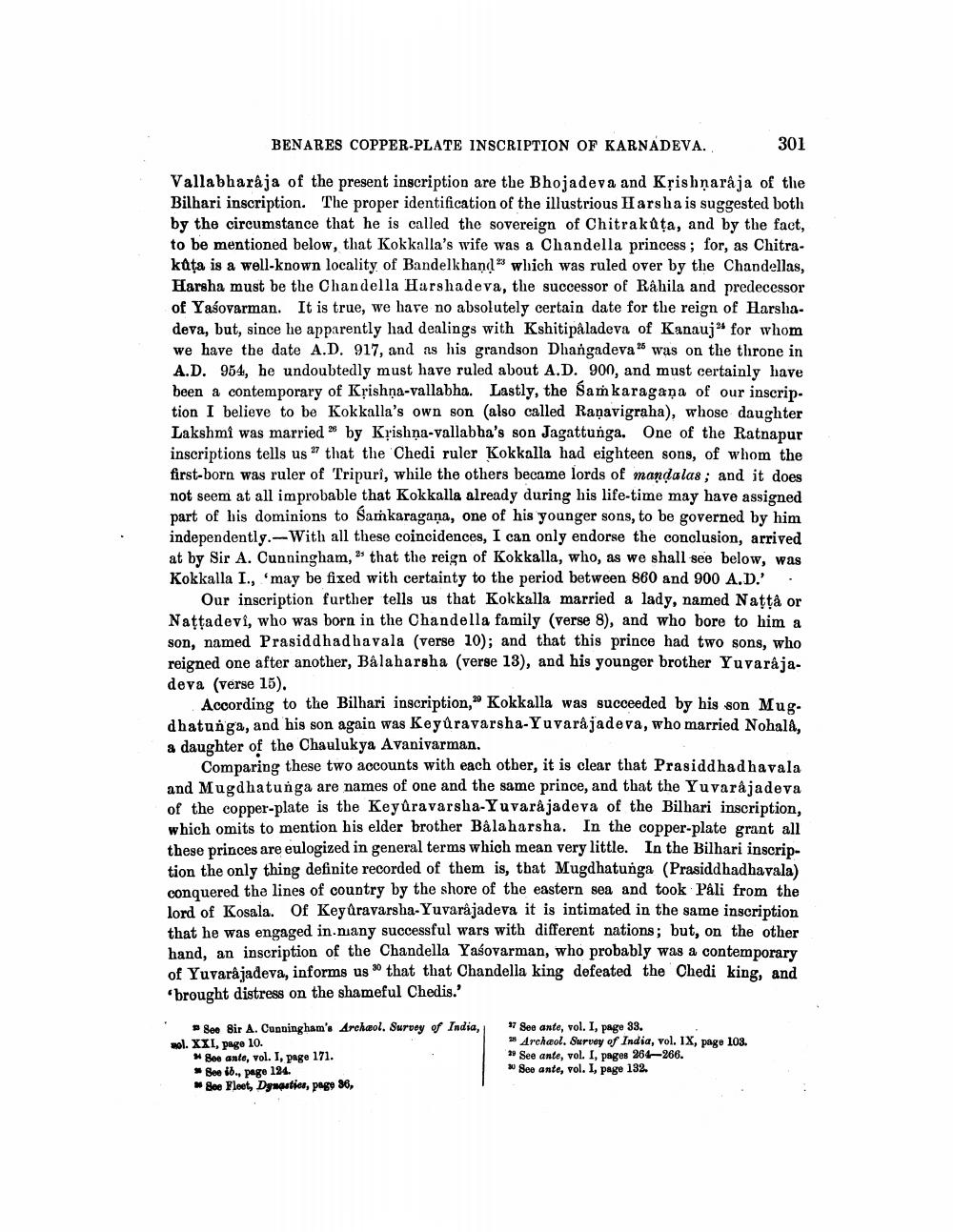________________
BENARES COPPER-PLATE INSCRIPTION OF KARNADEVA.
301
Vallabharaja of the present inscription are the Bhojadeva and Krishṇaraja of the Bilhari inscription. The proper identification of the illustrious Harsha is suggested both by the circumstance that he is called the sovereign of Chitrakața, and by the fact, to be mentioned below, that Kokkalla's wife was a Chandella princess; for, as Chitrakata is a well-known locality of Bandelkhand " which was ruled over by the Chandellas, Harsha must be the Chandella Harshadeva, the successor of Râhila and predecessor of Yasovarman. It is true, we have no absolutely certain date for the reign of Harshadeva, but, since he apparently had dealings with Kshitipåladeva of Kanauj* for whom we have the date A.D. 917, and as his grandson Dhangadeva was on the throne in A.D. 954, he undoubtedly must have ruled about A.D. 900, and must certainly have been a contemporary of Krishna-vallabha. Lastly, the Saṁ karagana of our inscription I believe to be Kokkalla's own son (also called Raņavigraha), whose daughter Lakshmi was married " by Krishna-vallabha's son Jagattunga. One of the Ratnapur inscriptions tells us that the Chedi ruler Kokkalla had eighteen sons, of whom the first-born was ruler of Tripuri, while the others became lords of mandalas ; and it does not seem at all improbable that Kokkalla already during his life-time may have assigned part of his dominions to Samkaragana, one of his younger sons, to be governed by him independently. With all these coincidences, I can only endorse the conclusion, arrived at by Sir A. Cunningham," that the reign of Kokkalla, who, as we shall see below, was Kokkalla I., may be fixed with certainty to the period between 860 and 900 A.D.' .
Our inscription further tells us that Kokkalla married a lady, named Nattå or Națţadevi, who was born in the Chandella family (verse 8), and who bore to him a son, named Prasiddhadhavala (verse 10); and that this prince had two sons, who reigned one after another, Bålaharsha (verge 13), and his younger brother Yuvaraja. deva (verse 15).
According to the Bilhari inscription, Kokkalla was succeeded by his son Mug. dhatunga, and his son again was Keguravarsha-Yuvara jadeva, who married Nohala, a daughter of the Chaulukya Avanivarman.
Comparing these two accounts with each other, it is clear that Prasiddhadhavala and Mugdhatunga are names of one and the same prince, and that the Yuvarajadeva of the copper-plate is the Keyūravarsha-Yuvarajadeva of the Bilhari inscription, which omits to mention his elder brother Bålaharsha. In the copper-plate grant all these princes are eulogized in general terms which mean very little. In the Bilhari inscription the only thing definite recorded of them is, that Mugdhatunga (Prasiddhadhavala) conquered the lines of country by the shore of the eastern sea and took Páli from the lord of Kosala. Of Keyūravarsha-Yuvarâjadeva it is intimated in the same inscription that he was engaged in.niany successful wars with different nations; but, on the other hand, an inscription of the Chandella Yasovarman, who probably was a contemporary of Yuvarâjadeva, informs us that that Chandella king defeated the Chedi king, and 'brought distress on the shameful Chedis.'
See Bir A. Cunningham's Archæol. Survey of India, nol. XXI, page 10.
* See ante, vol. I, page 171. Bee 18., Page 124. See Fleet, Dynastics, pago 86,
97 See ante, vol. I, page 33. * Archæol. Survey of India, vol. IX, page 103. * See ante, vol. I, pages 264–266. * See ante, vol. I, page 132.




